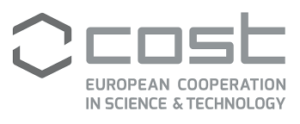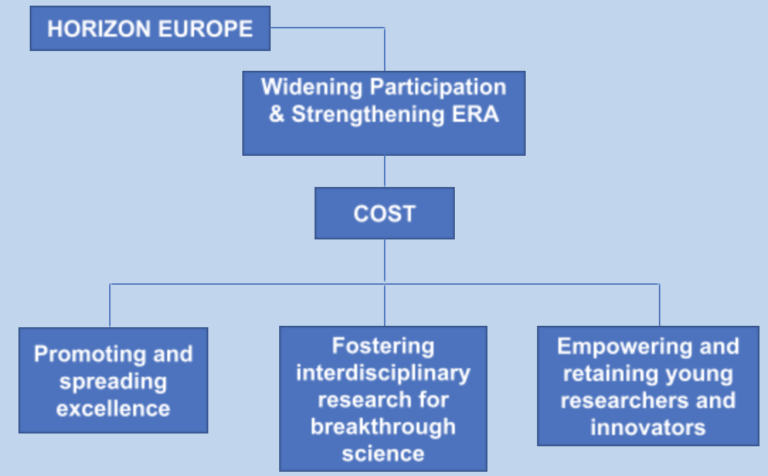
European Cooperation in Science and Technology
General information
Previous name: COST - European Cooperation in Science and Technology
Organigram
Since 1971, COST has received EU funding under the various research and innovation framework programmes. The COST Association, an international not-for-profit association under Belgian law, is located in Brussels and carries out all activities related to this Open Call. The COST Members established the COST Association, in September 2013. Its decision-making body is the general assembly of Members, the Committee of Senior Officials (CSO). Other legal bodies are the Executive Board, the COST Director and the COST Ministerial Conferences, which are organised every five years to gather the support and commitment of the Members’ national governments. Each Member and the Cooperating Member Israel nominate a COST National Coordinator. The COST Scientific Committee advises the COST Association about the Open Call, its quality and procedures.

Introduction
It is a pan-European intergovernmental framework dedicated to interdisciplinary networking activities for researchers (EU and beyond) to jointly develop their own ideas and new initiatives across all scientific and technological fields through trans-European coordination of nationally funded research activities. It receives financial support from “Spreading Excellence and Widening Participation” under Horizon 2020.
Focus of funding for 2021-2027
3 priorities: 1.Promoting and spreading excellence; 2.Fostering interdisciplinary research for breakthrough science; 3.Empowering and retaining young researchers and innovators. COST is fully integrated into the successor of “Spreading Excellence and Widening Participation”, so 80% of its budget will be devoted to widening actions and 50% of its budget will be invested in widening eligible countries (ITC).
Thematic Priorities
- Research & Innovation
Participating countries
- All COST members
- Non-COST Members can join based on mutual benefit:
- Near Neighbour Countries
- International Partner Countries
- Israel: Cooperating member
- South Africa: Partner member
Possible applicants
- Public and private institutions
- SMEs/Enterprises
- NGOs
- EU/International organisations
- Universities
- Research Institutes
Target group / Final beneficiaries
- Researchers
- Innovators
- Early career investigators
Budget
Total Budget for 2014-2020
EUR 300 million
Total Budget for 2021-2027
EUR 600 million
Increase / Decrease in %
Increase of 100%
Budget per project
150,000/year, for 4 years
Complexity of budget from 1 (easy) to 5 (difficult): 3
Criteria for the complexity of budget (How detailed is the budget, how complex is the documentation, availibility of documentation, etc.)
Budget lines:
- Meetings
- Training Schools
- Short Term Scientific Missions (STSM)
- Conference Grants for Early Career Investigators from ITC
- COST Action Dissemination
- Other Expenses Related to Scientific Activities (OERSA)
- Financial Scientific and Administrative Coordination (fixed percentage: 15% of the total expenditure of a Grant Period)
Tips for applicants on budgeting
- Where to find relevant information: Vademecum
- Contact in case of doubts: opencall@cost.eu
Tips for applicants on budgeting
- Actions are allocated a fixed budget for Grant Period (12mths)
- The Action Management Committee defines a Work and Budget Plan: it constitutes the Annex A to the Grant Agreement with activities of the Action and related costs
Programme-Specific Tips for Applicants
2-3 lessons learnt in 2014-2020
More budget under FP9: initiation of up to 75 new COST Actions per call, reaching 625 Actions per year with a success rate of 15% for submitted proposals (at present, 75% of the proposals rated as excellent cannot be funded due to lack of budget)
Programme Specific Practical Information
- Identify your research challenges and describe how networking helps tackle them
- Present a detailed plan to reach your objectives in 4 years
- Show you are able to engage the right stakeholders, having a balanced EU participation, gender representation and various career stages
- Explain how you will maximise the impact of your idea: evaluators favor proposals with potential high impact or that indicate emerging issues or potentially important future development. Evaluation criteria: S&T excellence: 15pts; networking excellence:15pts; impact:15 pts; implementation:5pts. Max score:50 pts. Threshold:34 pts.
- To launch an action, it is necessary to gather a minimum number of researchers. If the action is funded, a MoU is published so that other researchers can join. So, before submitting a new action, check whether an ongoing action exists. Fields: ICT; Materials, Physical and Nanosciences; Earth System Science and Environment Management; Transport and Urban Development; Food and Agriculture; Individuals, Societies, Cultures and Health; Biomedicine and Molecular Biosciences; Chemistry and Molecular Sciences and Technologies; Forests, their Products and Services; Trans-Domain Proposal.
Positive aspects
- Open to all scientific and technological fields: researchers can freely propose any topic
- Engaging the whole research community across countries, generations and gender
- Simple: one submission stage and user friendly IT tools
- Transparent: straightforward application process and independent peer review
Negative Aspects
- It does not fund pure research activities, but involved researchers bring on a common research project including research activities.
- Less budget for new participants joining the initiative at a later stage
Related Links
DOs and DON'Ts
DOs
01.
Involve 7 or more initial partners.
02.
Include training for early stage researchers.
03.
The call is very competitive, so prepare in due time the application.
DON'Ts
01.
Don’t underestimate the 15 pages template
02.
Don’t foresee too many working groups
03.
Don’t be vague in the description of the expected impact.
